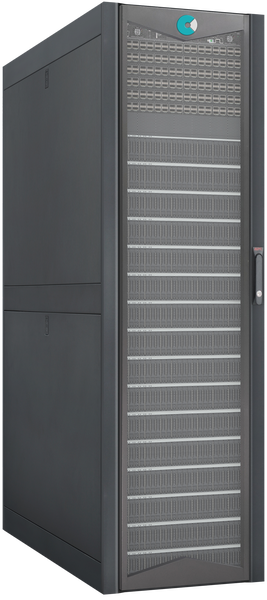HPE Cray ClusterStor E1000 Storage
For HPC, entry-level system starting at 30GB/s and 60TB
This is a Press Release edited by StorageNewsletter.com on November 5, 2019 at 2:22 pmCray, a Hewlett Packard Enterprise company, unveiled its ClusterStor E1000 system, aw parallel storage platform for the exascale era.

It addresses the growth of data from converged workloads and the need to access that data at speed, by offering an optimal balance of storage performance, efficiency and scalability, eliminating job pipeline congestion caused by I/O bottlenecks.
The next-gene global file storage system has already been selected by the US Department of Energy (DOE) for use at the Argonne Leadership Computing Facility, Oak Ridge National Laboratory and Lawrence Livermore National Laboratory, where the first 3 US exascale HPCs will be housed (respectively Aurora, Frontier and El Capitan).
With the introduction of the ClusterStor E1000 storage system, Cray has completed the re-architecture of its end-to-end infrastructure portfolio, which encompasses its Shasta supercomputers, Slingshot interconnect, and software platform.
“To handle the massive growth in data that corporations worldwide are dealing with in their digital transformations, a completely new approach to storage is required,” said Peter Ungaro, president and CEO, Cray. “Cray’s new storage platform is a comprehensive rethinking of what high performance storage means for the exascale era. The intelligent software and hardware design of ClusterStor E1000 orchestrates the data flow with the workflow – that’s something no other solution on the market can do.”
As the external high performance storage system for the first 3 U.S. exascale systems, ClusterStor E1000 will total over 1.3EB of storage for all three systems combined. The National Energy Research Scientific Computing Center (NERSC) also selected ClusterStor E1000, which will be the industry’s first all NVMe parallel file system at a scale of 30PB of usable capacity.
“NERSC will deploy the new ClusterStor E1000 on Perlmutter as our fast all flash storage tier, which will be capable of over four terabytes per second write bandwidth. This architecture will support our diverse workloads and research disciplines,” said NERSC director Sudip Dosanjh. “Because this file system will be the first all-NVMe file system deployed at a scale of 30PB usable capacity, extensive quantitative analysis was undertaken by NERSC to determine the optimal architecture to support the workflows our researchers and scientists use across biology, environment, chemistry, nuclear physics, fusion energy, plasma physics and computing research.”
ClusterStor E1000 enables organizations to achieve their research missions and business objectives faster by offering:
- Storage performance: it can deliver up to 1.6TB/s and up to 50 million I/O/s per rack – more than double compared to other parallel storage systems.
- Performance efficiency: New purpose-engineered end-to-end PCIe 4.0 storage controllers serve the maximum performance of the underlying storage media to the compute nodes and new intelligent Cray software, ClusterStor Data Services, allows customers to align the data flow with their specific workflow, meaning they can place the application data at the right time on the right storage media (SSD pool or HDD pool) in the file system.
- Scalability: An entry-level system starts at 30GB/s and at less than 60TB usable capacity. Customers can start at the size dictated by their current needs and scale as those needs grow, with maximum architectural headroom for future growth. The ClusterStor E1000 can connect to any HPC compute system that supports high speed networks like 200Gb/s Cray Slingshot, IB EDR/HDR and 100/200 GbE.
“Cray’s Shasta architecture substantially expands the company’s addressable market to include HPC simulation, AI, enterprise analytics and cloud computing. ClusterStor E1000 is an integral part of this strategy,” said Steve Conway, senior vice president of research, Hyperion Research. “This new edition of the proven ClusterStor solution is designed to enable leading enterprises to consolidate their AI, HPC and High Performance Data Analysis stacks, efficiently and easily. The fast-growing contingent of enterprises that are adopting HPC now have the cost-effective option to acquire a unified Cray Shasta-Slingshot-ClusterStor infrastructure.”
ClusterStor E1000 systems will be available starting in 1Q20.
Comments
This ClusterStor E10000 is a Lustre-based solution illustrating if needed that HPE has a real fuzzy strategy having its own offering and reselling partner product sometimes in competition with its own product line.
But it's not a surprise, HPE is a device/hardware company with real difficulties to engineer software and integrate acquisitions, we all remember PolyServe or Ibrix in the file storage space to just name a few.
This ClusterStor has a long story with 5 owners, starting as ClusterStor in 2008 by Peter Braam with Victor Walker and sold to Xyratex in 2010, then acquired in 2013 by Seagate, then sold to Cray in 2017 and now owned by HPE via the Cray acquisition.
This product Cray relies on open source, what a paradox but also a guarantee of long-term choice whatever become the vendor. This is a completely shift who what Cray used to offer with full proprietary stack - hardware plus software a few decades ago. But in HPC, the American government was (is) always in position to defend US leadership understanding that advanced computing was (is) a key business and represents a technology advantage for the country.
Cray adds its own developments and extension to Lustre 2.12 like GridRAID and ZFS. GridRAID comes from Sonexion and is a sophisticated mix of RAID-6 (8+2) and parity distribution across large number of storage devices.
We'll see how competition such IBM with Spectrum Scale, Lenovo with DSS-G based on Spectrum Scale, DDN with both ExaScaler and GridScaler respectively based on Lustre and Spectrum Scale and others like Panasas, Quobyte, Rozo, WekaIO and Vast Data even if in that case, the file interface is NFS, will react.
The coming Super Computing conference 2019 in Denver, CO, in 2 weeks will reserve some good surprises.












 Subscribe to our free daily newsletter
Subscribe to our free daily newsletter
